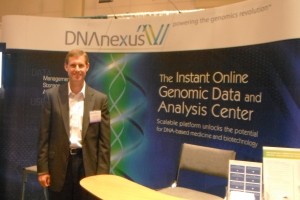We are back from Cambridge Healthtech Institute’s NGx Next-Generation Sequencing Data Analysis conference last week and more inspired than ever. The central theme from the 2012 meeting in Rhode Island? From listening to attendees and attending talks, the focus was on next-generation sequencing applications and their related challenges. Or more simply put, how the heck are we going to manage all this data? It appears this is the dawning of the cloud.
The plenary sessions on the first day really set the stage for the meeting and, it seemed to me, put a spotlight on the informatics and analysis issues that scientists are facing right now. Dick McCombie from Cold Spring Harbor Laboratory noted that his sequencing center is now producing about a terabase of genome sequence every month. George Weinstock, associate director of the Genome Institute at Washington University in St. Louis, said that if data output trends continue, in three years the Genome Institute will be churning out 100,000 human genomes per year. He also referred to two large data centers that were built across the street from the institute in the last several years to keep pace with the sequence being generated. Going forward, he said, continuing to add such centers at remarkably high cost will no longer be a solution.
 Here at DNAnexus, we agree wholeheartedly with that sentiment. Comments like this support our core value of moving the data storage and informatics headaches into the cloud so that biologists can focus on what they actually want to do. We think that whether users are from large genome centers or small institutions, there is significant benefit to putting data in the cloud so people do not have to worry about internal data management resources and challenges.
Here at DNAnexus, we agree wholeheartedly with that sentiment. Comments like this support our core value of moving the data storage and informatics headaches into the cloud so that biologists can focus on what they actually want to do. We think that whether users are from large genome centers or small institutions, there is significant benefit to putting data in the cloud so people do not have to worry about internal data management resources and challenges.
It was also interesting to hear how significantly the balance is shifting between biology and the computational side. According to Weinstock, some 40 percent or 50 percent of the institute staff are informatics or analysis people — a major increase from the norm just a few years ago. In another talk, Vanessa Hayes from the J. Craig Venter Institute said that for every one person they have generating data, they have 10 others engaged in managing and interpreting that data. It’s quite an eye opener when you think back to the days when computational biology was a small add-on to the average wet lab.
Hearing about the increasing number of people dealing with data analysis resonates with us; after all, this is why we built the DNAnexus tool to enable collaborations. We think that a community-based approach is important for this field, so we came away from the NGx conference more convinced than ever that our cloud-based solution has a lot to offer people working with DNA sequence data. Feel free to check out our current offering now with a complimentary trial, or sign up at www.dnanexusX.com to receive updates as we prepare to launch our new community-centered platform soon.

.png)
.png)
.png)